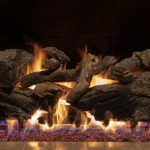How To Choose Gas Fireplace Logs
 Gas fireplace logs offer the warmth and ambiance of a traditional wood-burning fireplace without the hassle of chopping and storing firewood. With their convenience and efficiency, they have become a popular choice for homeowners. However, choosing the right gas fireplace logs for your home can be overwhelming due to the wide variety of options available. In this blog post, we will guide you through the factors to consider when selecting gas fireplace logs to ensure you make the right choice for your needs.
Gas fireplace logs offer the warmth and ambiance of a traditional wood-burning fireplace without the hassle of chopping and storing firewood. With their convenience and efficiency, they have become a popular choice for homeowners. However, choosing the right gas fireplace logs for your home can be overwhelming due to the wide variety of options available. In this blog post, we will guide you through the factors to consider when selecting gas fireplace logs to ensure you make the right choice for your needs.
1. Fuel Type
There are different fuel types available for gas fireplace logs, including natural gas and liquid propane. The fuel type you choose will depend on what is available in your area and the setup of your home. Natural gas is typically more convenient since it is supplied through a utility company’s pipeline system. On the other hand, liquid propane requires a dedicated tank that needs to be refilled periodically. Consider the availability and cost of these fuel options in your area when choosing gas fireplace logs.
2. Size and Fit
Gas fireplace logs come in various sizes, ranging from small to large. Consider the size of your fireplace and the aesthetics you wish to achieve when selecting the log size. It is important to choose logs that fit well in your fireplace and provide a realistic appearance. Logs that are too large or small can look out of proportion and may not generate sufficient heat. Measure the dimensions of your fireplace to ensure the logs you choose will fit appropriately and provide the desired visual effect.
3. Log Material
Gas fireplace logs are available in different materials, including ceramic, refractory cement, and ceramic fiber. Each material has its own advantages and disadvantages. Ceramic logs are known for their realistic appearance and long-lasting durability. Refractory cement logs offer a similar appearance to ceramic logs and are resistant to high heat. Ceramic fiber logs are lightweight and have excellent heat retention properties. Consider the durability, heat resistance, and visual appeal of the log material when making your selection.
4. Log Style
The style of gas fireplace logs can greatly impact the overall look of your fireplace. There are various log styles available, including oak, birch, pine, and more. Consider the design and ambiance you want to create when choosing the log style. Different log styles can complement different interior design themes, such as rustic, modern, or traditional. Take into account the color, texture, and shape of the logs to choose a style that matches your aesthetic preferences.
5. Log Placement
Before purchasing gas fireplace logs, consider how you want them to be arranged in your fireplace. Some logs come as a set with predetermined placements, while others allow for customization. If you prefer a specific arrangement, look for logs that can be positioned individually to achieve the desired look. Flexible log placement allows for greater creativity and customization to ensure your fireplace reflects your personal style.
6. Heating Efficiency
One of the advantages of gas fireplace logs is their heating efficiency. Gas logs can generate a significant amount of heat while still providing a realistic flame appearance. When selecting gas logs, consider their heat output in BTUs (British Thermal Units). Higher BTU ratings indicate greater heating capacity. Choose logs with the appropriate BTU rating for the size of the space you want to heat. Consulting with a professional can help you determine the appropriate BTU rating for your specific needs.
7. Safety Features
Safety should always be a top priority when choosing gas fireplace logs. Look for logs that are certified by safety organizations, such as CSA (Canadian Standards Association) or ANSI (American National Standards Institute). These certifications ensure that the logs meet strict safety standards and have undergone rigorous testing. In addition, consider features such as oxygen depletion sensors (ODS) and automatic shut-off valves, which add an extra layer of safety by detecting low oxygen levels and automatically shutting off the gas supply.
Summary
Choosing gas fireplace logs requires careful consideration of factors such as fuel type, size, log material, log style, log placement, heating efficiency, and safety features. By evaluating these factors, you can select gas logs that fit your fireplace, provide the desired aesthetic appearance, and meet your heating needs. Whether you are aiming for a rustic, modern, or traditional look, there are gas logs available to enhance the ambiance of your fireplace and make it a focal point in your home.
Need Fireplace Installations in Palmer, AK?
Alaska Fire and Flue LLC has been serving Eagle River and the Mat-Su Borough since 2005 and recently opened a 2000 sq ft showroom at 6445 Blue Lupine Dr in Palmer. We are your full-service dealer for wood stoves, fireplaces, chimney, and all the accessories to keep you burning wood all winter. At Alaska Fire and Flue LLC, we carry a diverse range of stoves to meet your heating needs. Come into our showroom and view our gas, pellet, Toyo, oil, and wood burning stoves. We are committed to providing top of the line service and repair for any type and style of stove, chimney, and fireplace. Contact us today for your new heating system or just to ask any technical questions that you may have!
Categorised in: Gas Fireplaces
